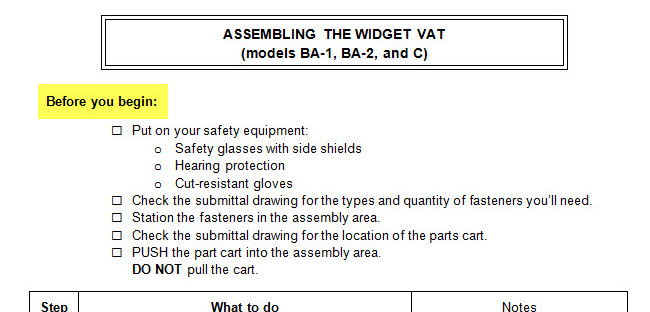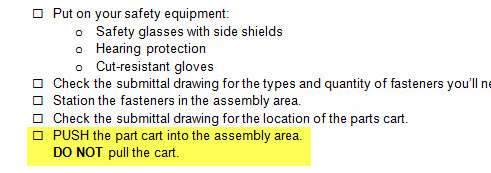(A makeover: the after version. Here’s the before.)

In the previous post, I showed a fictionalized example of an actual guide for assembling a piece of industrial equipment. The original, written on seventeen sheets in an Excel workbook, had more than 50 steps. I didn’t fictionalize them all, and I haven’t tried to revise them all. I’ve done two pages that cover what 5 of the original pages did. I think these revisions are representative. (You can click each image to open a full-sized version in another window.)
By the way: I don’t have any documentation other than what’s in the original widget vat instructions. In some places, I’ve made an educated guess about details that aren’t clear; in other cases I made things up. I’ll point these out along the way.
On to the revision!
How we got here

There are a lot of steps to follow in assembling a widget vat. Based on their number, and their occasional complexity, and on my assumption that speed is not a major factor, a job aid makes sense.
And many of my revisions are part of what any good job aid should include.
A clear title
The original title, “Main Assembly Instructions,” was at best ambiguous, unless Quasimodo Corporation only assembles one thing.
Here I’m imagining that there are several models of widget vats that differ mainly in size. I’ve put the model numbers into the title so the assemblers can tell easily if these are the instructions they want.
First things first: safety and prerequisites
Every page of the original version had a box listing the same three pieces of safety equipment–as if the developer thought the assemblers might take off their safety glasses between pages 11 and 12. I’ve put them at the beginning, on the assumption that you shouldn’t be roaming the plant without your safety equipment.
I’m also assuming that the “submittal drawing” spells out things like how many fasteners you need of each type. If that were not the case, I’d have to find out from my client whether (for example) the fasteners were stored at the assembly point, and if so how the workers could get more when they needed.
Emphasizing what’s important
The original version didn’t make much effective use of contrast, alignment, or spacing, so it’s much harder to figure out what’s important. And USING ALL CAPS IS PRETTY MUCH SAYING “WHO NEEDS EMPHASIS?”
Good job aids use emphasis techniques (like capitals, boldface, or italics) in specific, consistent, limited circumstances. One of the most obvious circumstances is to highlight warnings and exceptions–DO NOT, EXCEPT, UNLESS, DANGER, and so on.
Don’t confuse people with detail
The original used over 50 photos; in my revision I’ve hardly used any. In part that’s because I didn’t have good replacements for the photos–but also because many of the original photos fail to contribute useful guidance.
One problem with the original images–and with photos in general–is that they often provide too much detail, making it hard to grasp what’s important. Or they ignore context, also making it hard to grasp what’s important.
Take a look at these three examples from the original (click to enlarge):

- Left: Why do I need to see a picture of the parts cart? The instructions say it’s important to push rather than pull the cart–but they don’t say if there’s a specific end I should push from. If there is, show it. If there isn’t, spell that out.
- Center: you might be able to figure out, after studying this picture, that you’re viewing the assembly area from the side–but you can’t tell whether the top of the assembled widget will be on the left or the right.
- Right: the instructions tell you:
- CHOCK ONE (1) WHEEL ON EACH END OF EACH VAT ASSEMBLY FIXTURE (FOUR (4) CHOCKS TOTAL).
- In my first revision, I’d missed the “four chocks total” part, which implies that neither the all-caps approach nor the FOUR (4) text/numeral approach helped.
 Although I didn’t have much to work with, I have a couple of examples of images I think would work better.
Although I didn’t have much to work with, I have a couple of examples of images I think would work better.
The top picture in “image detail” shows a closeup helpful for one assembly step: the flanges should face up, and they should face out from each other.
(Yes, I made up the term “bleem flange.”)
The lower picture is a line drawing rather than a photo. Line drawings are a great way to eliminate unnecessary detail. I’ve teried to reduce details to the essentials: you’re fastening two (more-or-less) L-shaped pieces together, and you fasten through holes that alternate large/small/large/small.
(I’ve made the assumption here that the assembler should alternate directions when fastening these things: one fastener from one side, the next from the opposite side. If it were important to do that alternating while fastening, I’d add a box to spell that out. If you can install all the fasteners from one side, and then from the other, I’d spell that out. )
Some problems in the original version stem from the decision to always use three photos per page in the original. That’s a lot like deciding that you need to use one semicolon per paragraph: not wrong, exactly, but needlessly specific.
What I’d do instead:
- Leave out the cart photo. My assumption: the assemblers know what the parts cart looks like. If they don’t, they shouldn’t be assembling widget vats.
- Possibly include a close-up of the portion of the cart that I’m supposed to push, assuming there’s some sort of handle or push plate.
- Use a bird’s-eye-view line drawing to show the layout of the assembly area.
- In the text for this step in my revision, I made up some floor guidelines to show “top” and “bottom” of the assembled widget.
- I also made up guidelines on the frame to show where to place some of the initial pieces.
- Clarify where to place the wheel chocks.
- Chock one wheel of each assembly fixture.
- Written this way, it doesn’t matter how many fixtures you have, so you don’t need the FOUR (4) business so beloved by people writing procurement specs.
- Place the chock so it’s closer to the center of the fixture than the wheel it’s touching. (If this is a best practice; I have no idea.)
- Chock one wheel of each assembly fixture.
Trying to build a useful set of performance guides like this can be a tool for analysis tool as well. You can’t create a successful guide without knowing what the inputs are, what the process is, what the outputs are, and what the standards for success are.
How many assembly fixtures do I need? On the framework, which side represents the top of the assembled piece? Can I install 20 fasteners in one direction, all in a row, and then 20 in the other? And what the hell is a “submittal drawing,” let alone the cryptic “BOM?”
What’s more, you can identify items that don’t need to be in the guide. Frankly, I think it’s…perhaps less than helpful to list “vat part cart” as an assembly aid. That’s like saying, “In order to build your IKEA Poang chair, buy the Poang chair and bring it home.”



Well that looks a million times better! How many lifetimes will it take to update the rest of civilisation please? 🙂